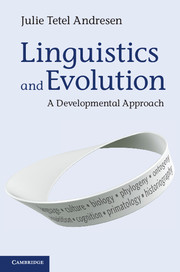Book contents
- Frontmatter
- Contents
- List of Figures
- Introduction Historiography’s contribution to theoretical linguistics
- Part I Theoretical considerations
- Part II A developmental systems linguistics
- Part III What to do next
- 8 Revisit: Skinner, Chomsky and construction grammar
- 9 Revise: introductory linguistics textbooks
- Bibliography
- Name index
- Subject index
9 - Revise: introductory linguistics textbooks
Published online by Cambridge University Press: 05 June 2014
- Frontmatter
- Contents
- List of Figures
- Introduction Historiography’s contribution to theoretical linguistics
- Part I Theoretical considerations
- Part II A developmental systems linguistics
- Part III What to do next
- 8 Revisit: Skinner, Chomsky and construction grammar
- 9 Revise: introductory linguistics textbooks
- Bibliography
- Name index
- Subject index
Summary
At the beginning of Chapter 5, I noted that the difficulty of accounting for languaging on the evolutionary axis does not derive solely from the complexity of the behavior or the variety of disciplines involved in tackling it – though these aspects of the undertaking surely do pose distinct challenges. Rather, the difficulty of the problem lies in the fact that the question of the evolution of language – or, rather, the question of the instantiation, development and maintenance of the human languaging network – has some of the most historically embedded conceptual baggage to unpack before one can move forward. In fact, the very subject matter of the discipline of linguistics – usually called language – is similarly bedeviled.
Throughout Linguistics and Evolution, I have used historiography as a kind of talk therapy for the discipline and, over the course of the chapters, I have effected some chiropractic adjustments. First, I enlarged the scope of linguistic history by weaving a minor tradition of thought about our subject matter into our history, that minor tradition being concerned with “languaging as an orienting behavior.” Second, I argued that a shift toward understanding of our subject matter not as language but as languaging eases the incorporation into the discipline of the latest findings in the social and biological sciences. Third, I outlined the abandonment of a rationalist-realist framework and offered developmental systems theory in its stead. Because developmental systems theory factors in time, both ontogenic and phylogenic, into its very framework, the anxiety of how to account for languaging on the evolutionary axis does not become easier but it does become less problematic, and ontogenic explanations open onto the whole of a languaging living being’s lifetime. If what has been said throughout these chapters has a use, then I would like to think it could be in the service of reshaping introductory linguistics textbooks.
- Type
- Chapter
- Information
- Linguistics and EvolutionA Developmental Approach, pp. 260 - 280Publisher: Cambridge University PressPrint publication year: 2013

